Review: With the iPhone 5S
Every year since 2008, Apple has released new flagship iPhones in a predictable cadence: on even years we get a new external design; on odd years we get a refinement of the previous year's design with upgraded insides and new hardware features. Apple continues to issue updates in this comfortable, almost leisurely stride even as the Android vendors are releasing new high-end, tentpole products every six months or so.
This year is no exception. Apple's iPhone 5S is a tweaked version of the iPhone 5 that retains the same screen and physical dimensions of its predecessor. It swaps out the A6 chip for the faster A7 and adds some features that its predecessors aren't privy to. But the 5S also arrives alongside the iPhone 5C and iOS 7, and taken together the three new products are the biggest overhaul the iPhone line has gotten in years.
Our review will take a dive into the most important new features of the 5S, comparing them not just to the iPhone 5 (and thus, the 5C) but also to the iPhone 4Ss that many will be looking to upgrade. Is the phone significant enough that you should run out and get it, or should you wait for the inevitable iPhone 6?
Body, build quality, and screen
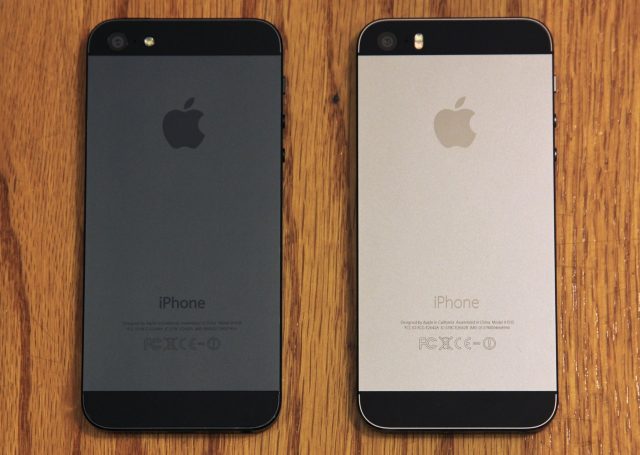
Enlarge / The black iPhone 5 (left) compared to the much lighter "space gray" iPhone 5S (right).
Andrew Cunningham
| SPECS AT A GLANCE: APPLE IPHONE 5S | |
|---|---|
| SCREEN | 1136×640 4-inch (326PPI) touchscreen |
| OS | iOS 7 |
| CPU | 1.3GHz Apple A7 |
| RAM | 1GB DDR3 |
| GPU | "Apple A7 GPU" (likely an Imagination Technologies 6-series variant) |
| STORAGE | 16, 32, or 64GB NAND flash |
| NETWORKING | 802.11a/b/g/n, Bluetooth 4.0 |
| PORTS | Lightning connector, headphone jack |
| SIZE | 4.87" × 2.31" × 0.30" (123.8 × 58.6 × 7.6 mm) |
| WEIGHT | 3.95oz (112 g) |
| BATTERY | 1560mAh |
| STARTING PRICE | $199 with two-year contract, $649 unlocked |
| OTHER PERKS | Charger, earbuds, Lightning cable |
The short version: The 5S is a whole lot like an iPhone 5.
The long version: This is always the shortest part of the "S" phone reviews. In terms of weight and physical dimensions, the iPhone 5S is every bit the equal of the iPhone 5. It's 0.30 inches thick and weighs 3.95 ounces, which makes it thinner and lighter than many competing (albeit larger-screened) Android phones and also the iPhone 4S models that at least a few people will be upgrading from. What looked sort of awkward and tall last year (at least when compared to previous iPhones) now looks completely familiar.
There are a handful of ways to tell a 5S from a 5 at a glance. One is the new Home button, which has been changed to accommodate the fingerprint sensor. Another is the oval cutout to the right of the upgraded camera that shows off the dual-LED flash. If you happen to actually get your hands on one, you may notice that it feels substantially faster than the iPhone 5 as well (and the 5 is definitely not slow).
If you're looking for something even more obvious, you can look for the new colors the 5S comes in. The silver-and-white option from last year is still around, but the black model has been replaced with a new, lighter model that Apple calls "space gray." This new color uses aluminum with a lighter anodization than the old black model. While it's difficult to say for sure, it seems like the new color will display scratches and scuffs less readily than the old black model did. And of course there's the gold model, which as we know can prompt people to get a little crazy.
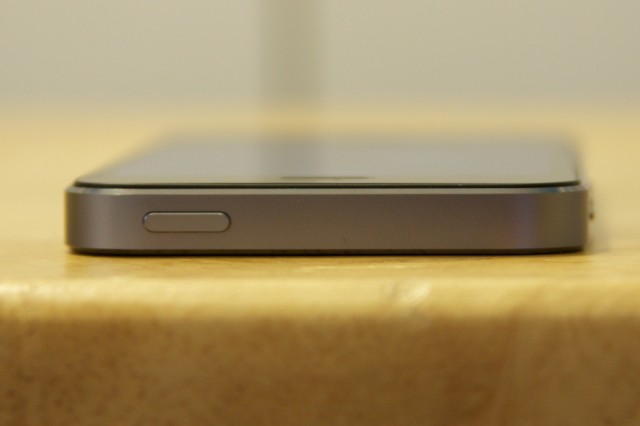
Enlarge / The power button on top of the 5S.
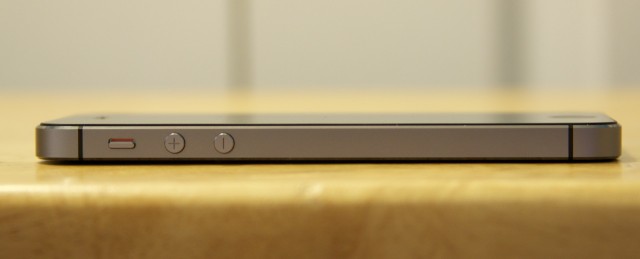
Enlarge / The round volume buttons and mute switch on the left side.
Andrew Cunningham
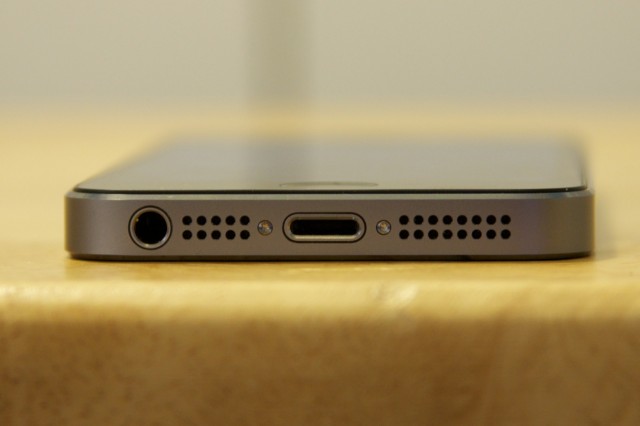
Enlarge / The headphone jack, speaker grilles, and Lightning port on the bottom of the phone.
Andrew Cunningham
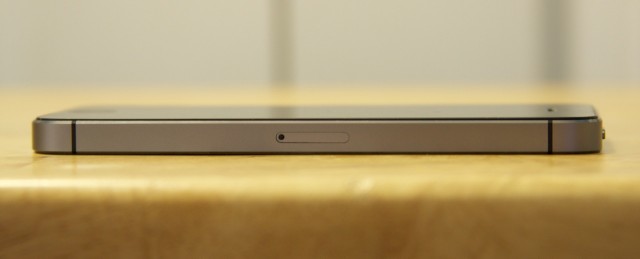
Enlarge / The SIM tray on the right side.
Andrew Cunningham
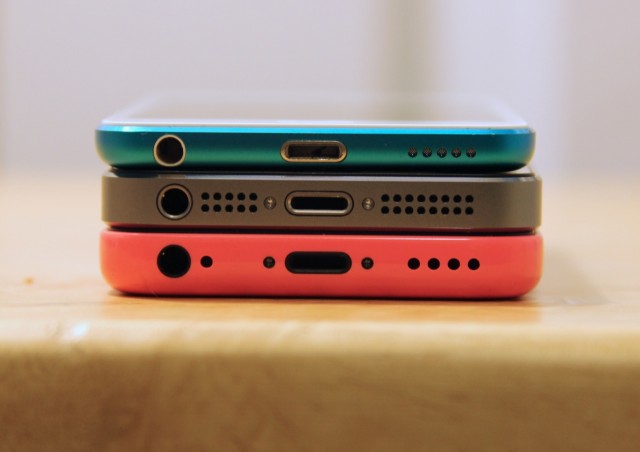
Enlarge / The iPhone 5C, iPhone 5S, and fifth-generation iPod touch stacked on top of one another.
Andrew Cunningham
Having the same body as last year's phone means it shares the same screen as well, which is a blessing and a curse. The good part is that the 1136×640 326 PPI screen still looks pretty good, especially with the lighter design of iOS 7. The bad part is that the screen has been surpassed in size and density by other phones within its price range. Even if you don't care much for truly big phones like the Galaxy S 4 and HTC One, phones like the Moto X have shown that it's possible to squeeze a larger screen into a body that isn't uncomfortable to hold. Rumors that Apple is testing different screen sizes crop up regularly—if you were hoping for a larger iPhone, you're just going to have to cross your fingers and look toward next year. If you enjoy that the iPhone is a premium device that maintains a relatively small screen size, the 5S will keep you happy.
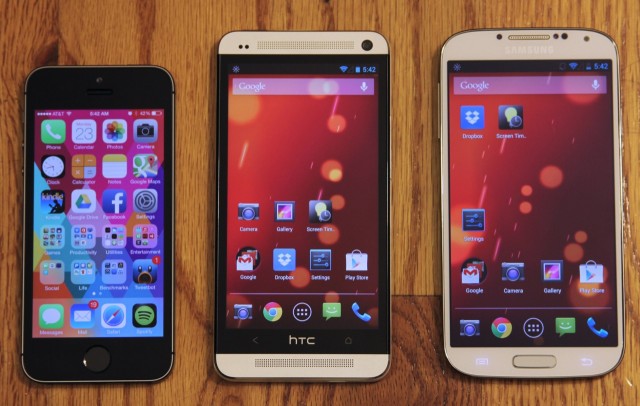
Enlarge / The 5S looks stunted next to the expansive HTC One (center) and Samsung Galaxy S 4 (right). The size you prefer is exactly that—your preference.
The look-and-feel of the phone remains the same as last year, but the fingerprint scanner, the camera, and the new internals are the real reason to upgrade. We'll spend the remainder of the review on these new aspects, but if you want to read more about how this phone looks and feels (and how it compares to older models like the iPhone 4 or 4S) our original iPhone 5 review will give you the gist of it.
Scanning fingerprints (and other things) with Touch ID

Enlarge / The iPhone 5S' fingerprint sensor is embedded in the phone's Home button, which loses the rounded square imprint present on other Home buttons but is otherwise clickable just as it is on any other iOS device.
Andrew Cunningham
The short version: Touch ID isn't perfect, but it ought to prompt most iPhone users to practice better security.
The long version: Even more than the camera or the A7 chip, the iPhone 5S' fingerprint reader is one of the strongest arguments in favor of the new phone. I unlock my phone dozens of times in a normal day, and anything that makes it easier or quicker to do without substantially reducing my security could easily save me a couple of hours in a given month (though definitions of what constitutes a substantial reduction of security will vary from person to person).
To use the feature, you must first register each individual finger you'd like to use in the phone's settings, found in the same place where you can set and change your passcode in other iOS devices. The software will walk you through the registration process, which asks that you rest your finger on the sensor repeatedly until it has completed a satisfactory scan of your fingerprint. Once scanned, you can delete and rename your different fingers within the software—if you get mixed up, hold your finger down on the sensor and the listing for that finger will flash briefly to indicate that it recognizes you. You can register up to five different fingers with the software. I find that registering both thumbs and the index finger on my dominant hand covers me in most circumstances, but some recommendusing a less-common finger like your pinky or ring finger to reduce the chance of someone opening the phone up with a lifted fingerprint.

No comments:
Post a Comment